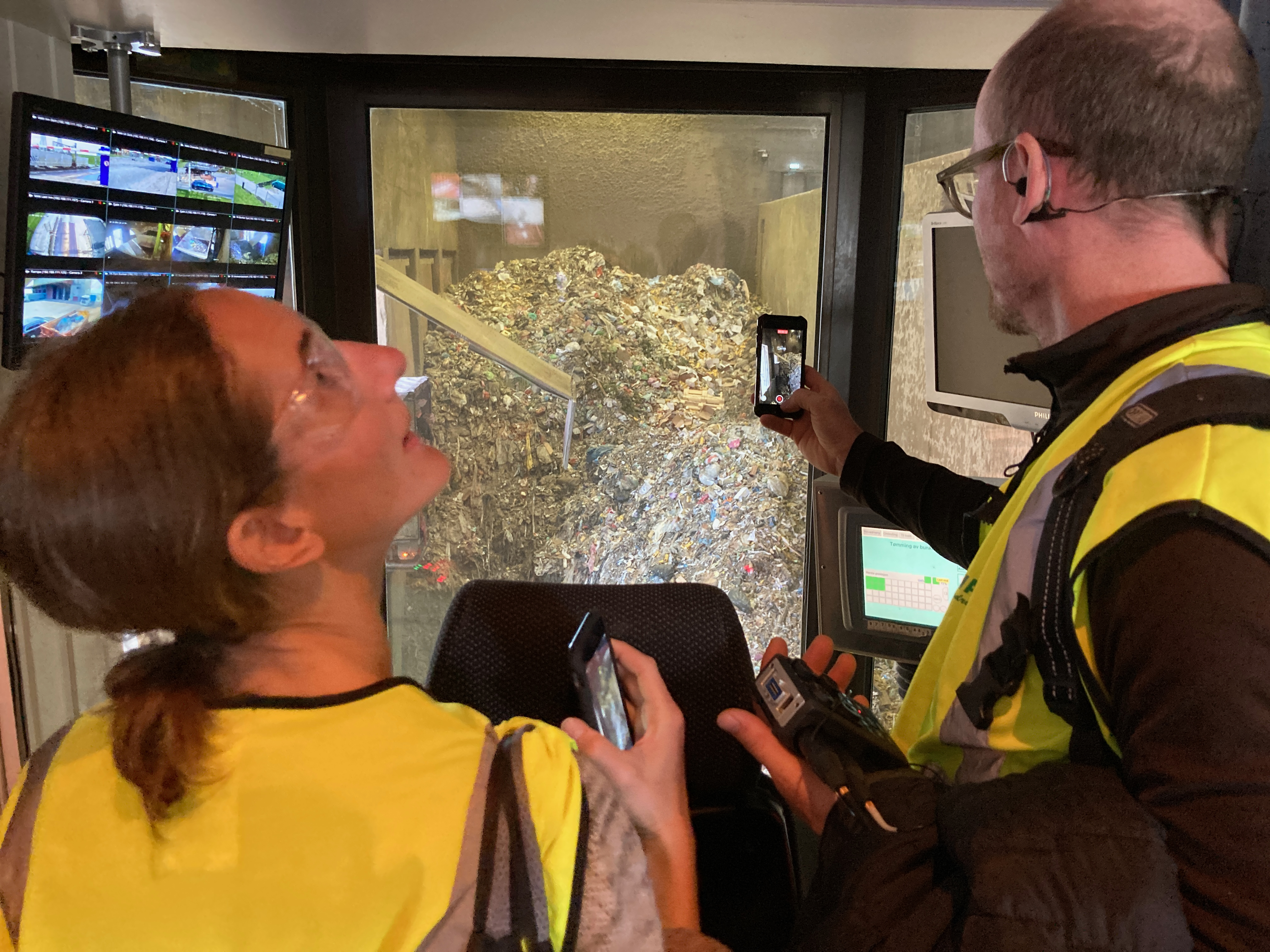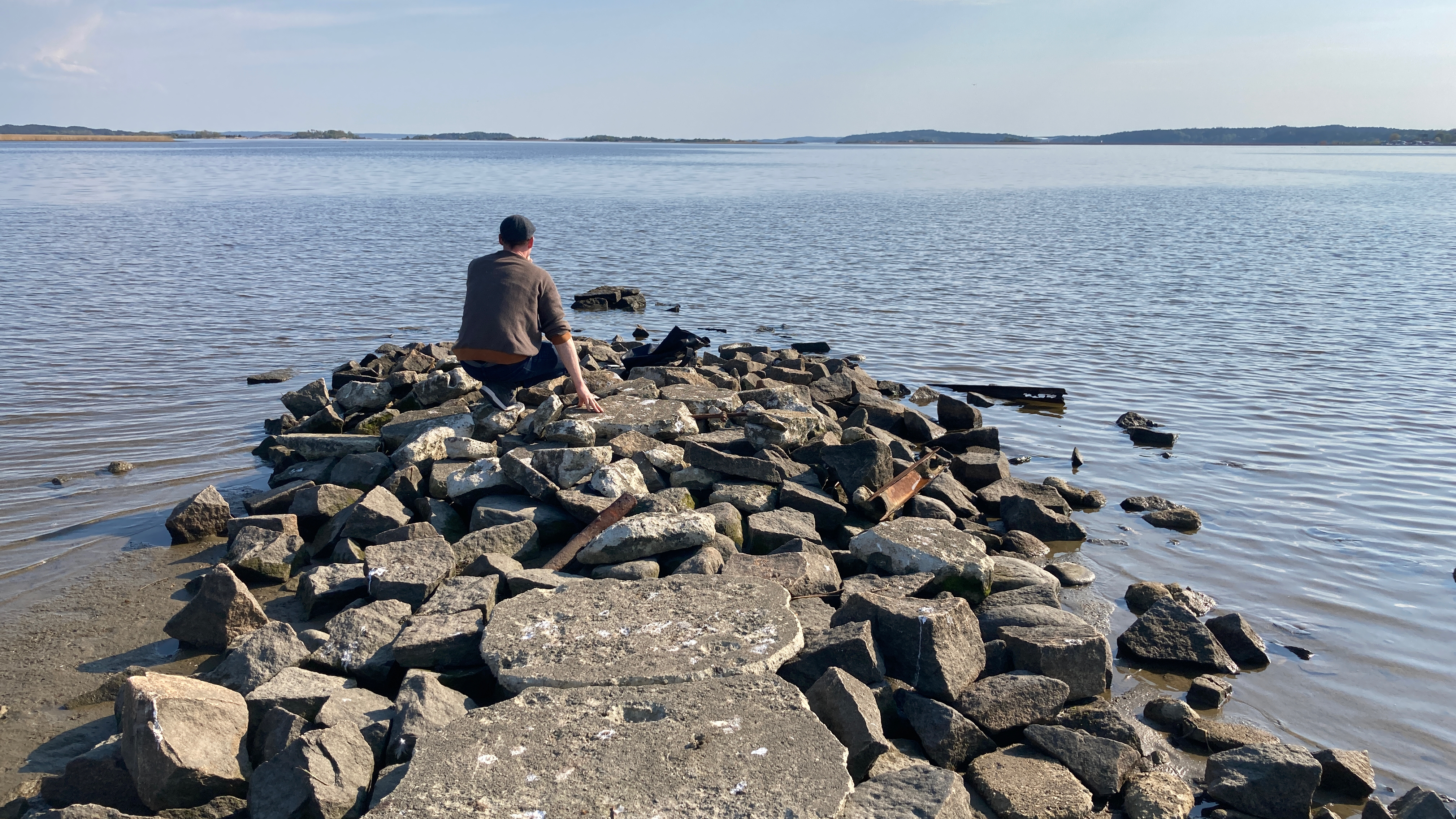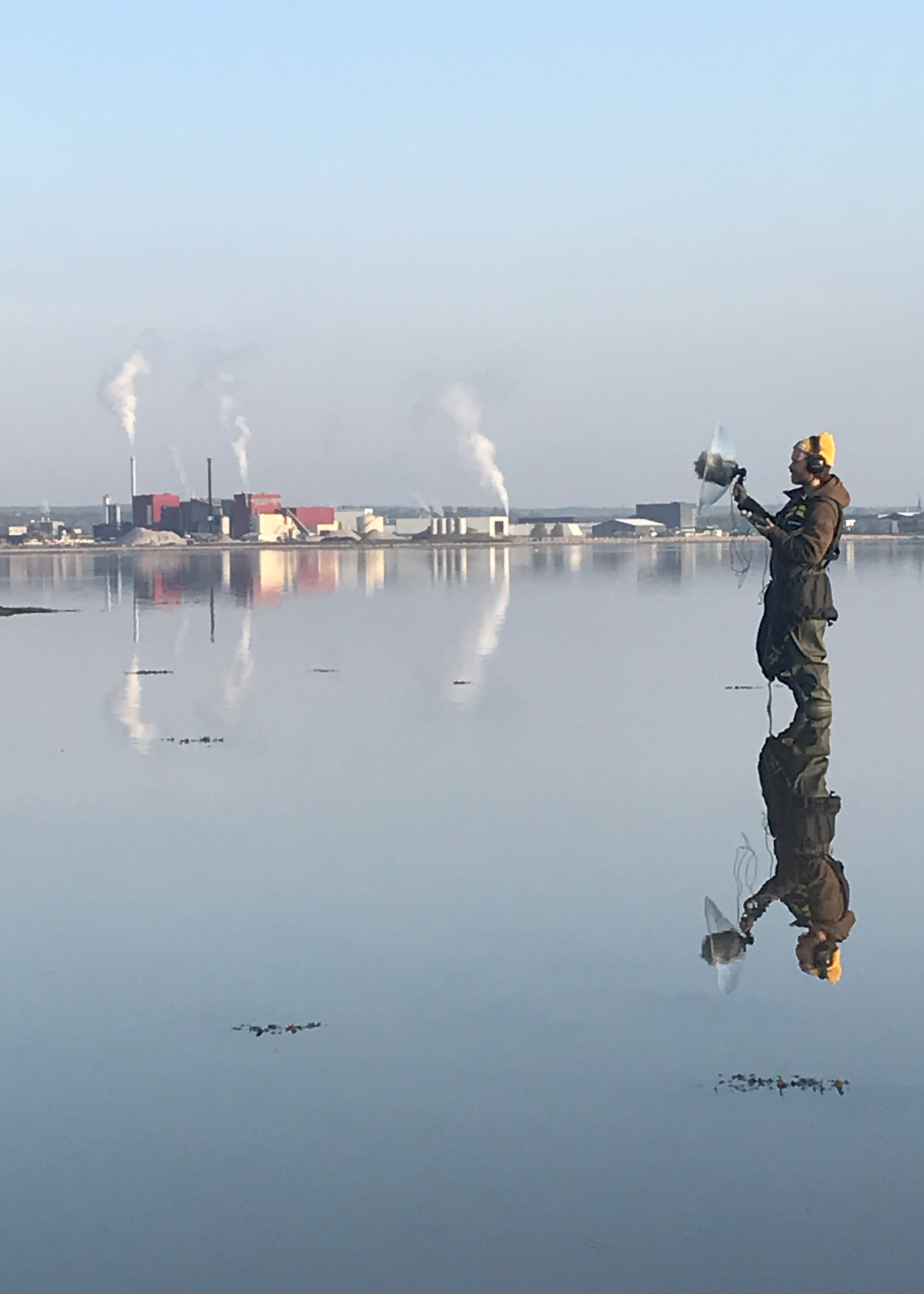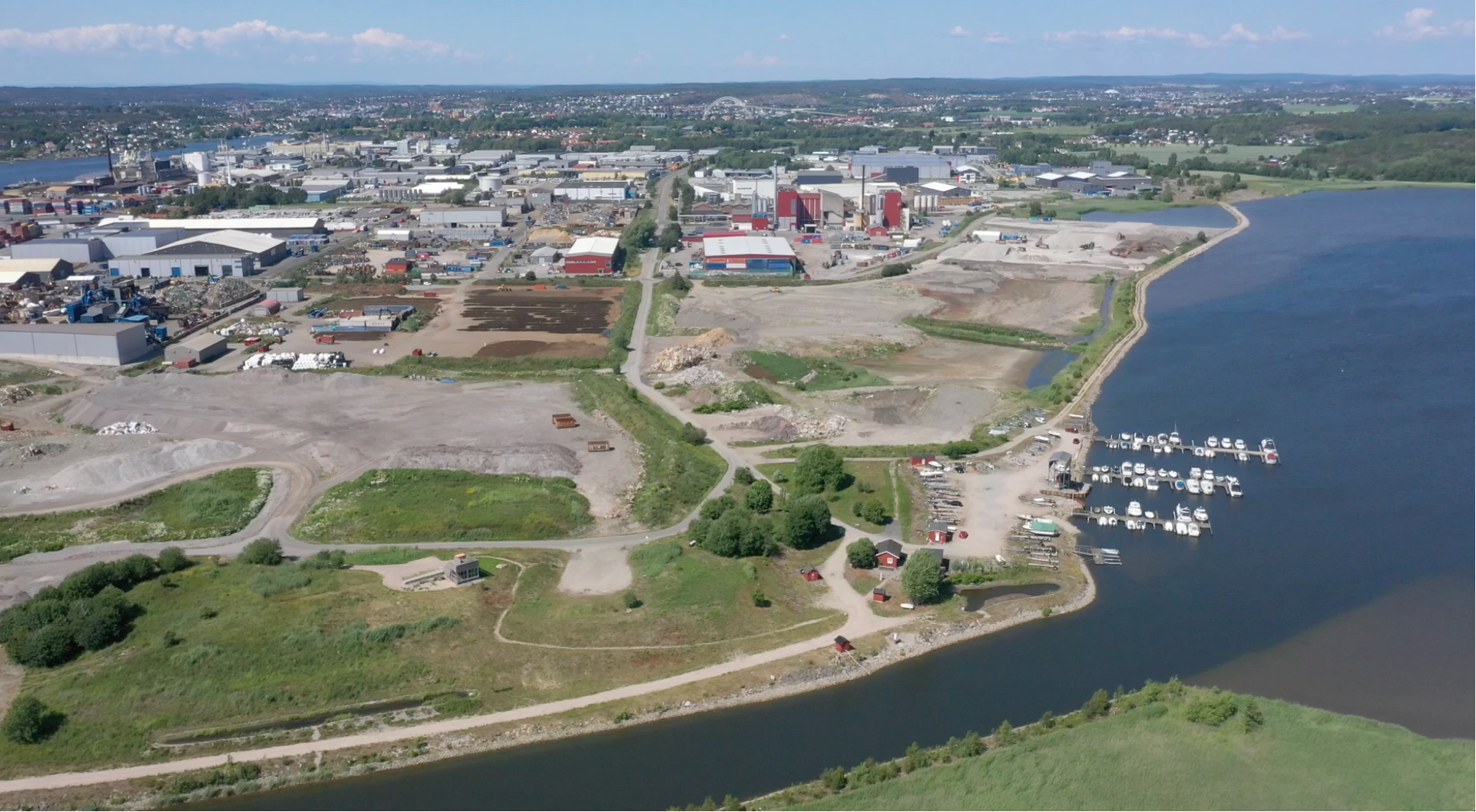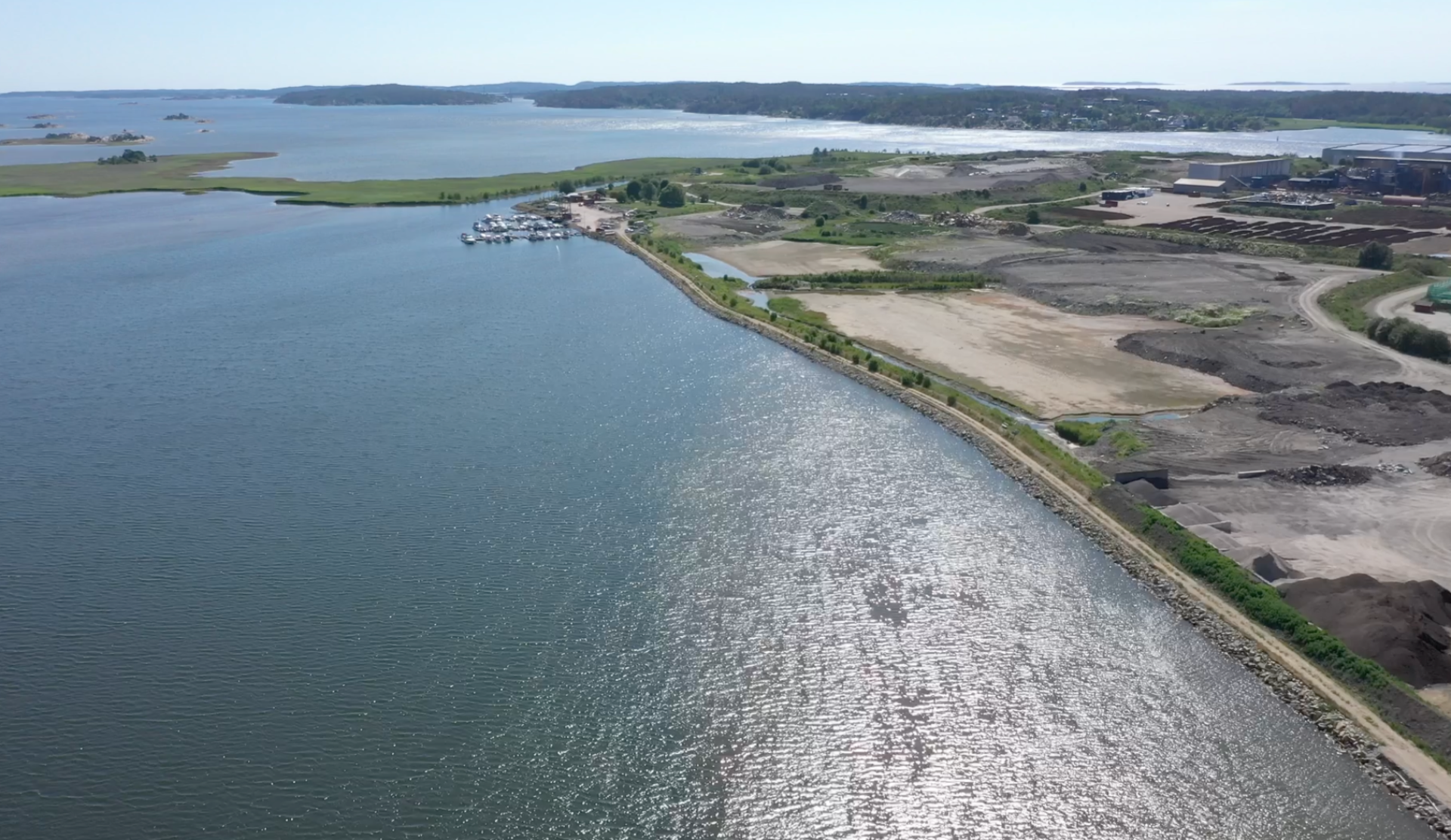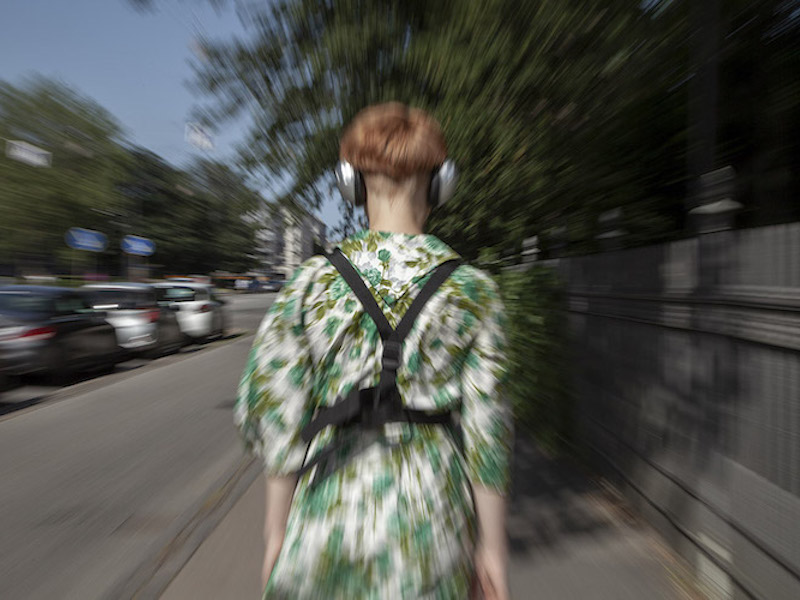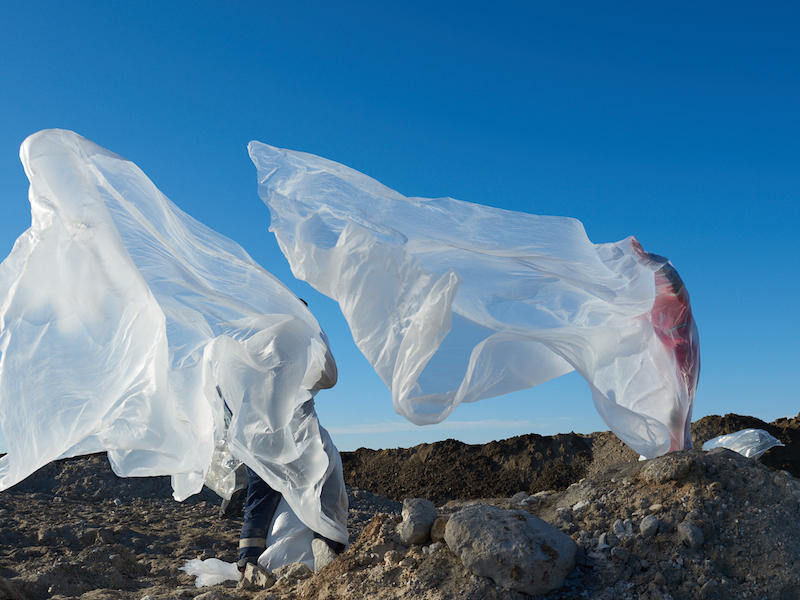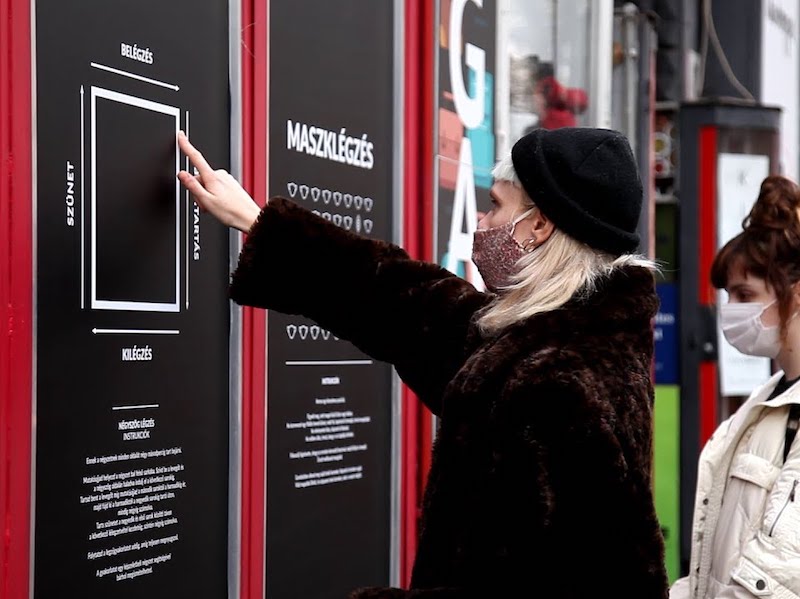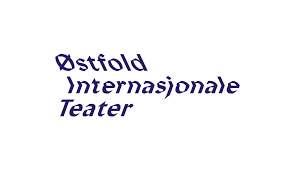 artists
artists
IN SITU Focus: a Conversation
with Johannes Bellinkx, Nana Francisca Schottländer, Eva Bubla and James Moore
10/10/2024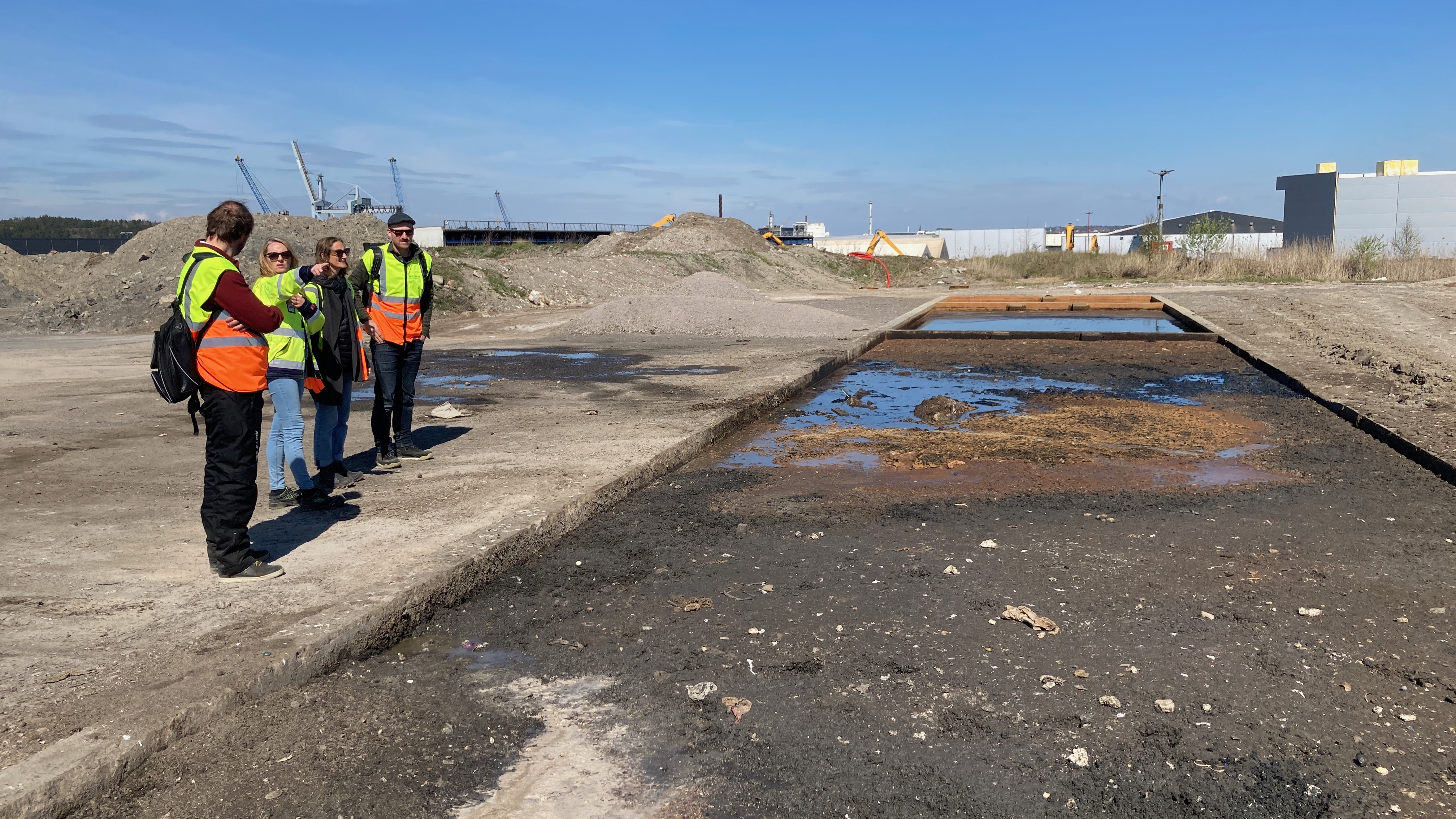
The conversation took place in May 2023 during parallel artistic residencies in Fredrikstad, Norway, in cabin belonging to the ornithological society BirdLife Østfold by the Øra Nature Reserve
The conversation took place in May 2023 during parallel artistic residencies in Fredrikstad, Norway, in cabin belonging to the ornithological society BirdLife Østfold by the Øra Nature Reserve, and was edited by Sjoerd Leijten (who was in residence together with Bellinkx). Each artist was currently undertaking one of several extensive residency periods to support there process of investigating and responding to the territory and its inhabitants – both human and more-than-human. The conversation reflects upon their process and local encounters on their way toward a public program in 2024.
James Moore, ØIT We're currently in Fredrikstad, Norway, and Østfold Internasjonale Teater has invited Eva Bubla, Johannes Bellinkx and Nana Francisca Schottländer to be in residence. This is a part of IN SITU project, (UN)COMMON SPACES 2020 to 2024, and we are now in May 2023 and working towards participating in a pilot program for a yet to be named festival anti festival with the program period from May to September next year, 2024. And we are in the border zone between Øra Nature Reserve and FREVAR (Fredrikstad Vann, Avløp of Renovasjon), which is Fredrikstad municipality's waste processing and energy production facility - in the Norwegian Ornithological Association's cabin for the Østfold chapter.
Johannes Bellinkx This is the area where I'm working right now. I am Johannes Bellinkx from Belgium, but I live in Holland. I'm working in this area because I'm very fascinated by it and because it's full of contrasts. And as we were discussing at the dinner table, a lot of the challenges that we are facing in this century are somehow expressed in this landscapes. The landscapes, they consist of the Ora National Park but protection area, and the FREVAR waste processing plant. And they're right next to each other. They're also collaborating or trying to collaborate. And of course, there's a lot of contradictory interests, but they're also trying to find common ground. And I think it's very interesting to see that it's also expressed in the landscape. And it's also says a lot about how we are dealing with our wastes and our footprints and our ways of behaving on this planet. I'm trying to create a work that questions this border because I think a lot of this border is constructed in our imagination. And I'm working with Sjoerd Leijten, he's here for three days to work with sounds. And I chose to work with sound because sound doesn't care so much about borders and about contrasts and about categories. So we tried some experiments with recording and listening to it with different perspectives. And I want to create installations where you are immersed in the different landscapes. The ideas are already crystallizing a bit. Yeah. I think I've found a nice direction to work in already. It's depends on a lot of things, but I think there is a direction in which we can proceed in the coming months or half a year at least.
Nana Francisca Schottländer Yeah. Yeah, I guess I can continue along those same lines. So I'm Nana Francisca Schottländer, I live in Copenhagen. I'm the associate artist of Metropolis in Copenhagen in this network. Here in Frederikstad, I've been coming a few times actually, now already kind of trying to zoom in on what are the dynamics and the topics and the different places or landscapes that I'm curious to explore. And where we are right now is also one of the places I have a bit more of a a scattered approach than Johannes. So right now I'm actually working with three different sites, trying to get to know them to understand what is at stake here, but also how these different sites are interconnected somehow. I was curious to explore places or landscapes that were shaped by human intervention, such as extraction or power production or other kinds of material intervention. And this led me to focus on three sites. One of them here. Fevar, the waste management facility. Another one is called Skolt Pukkverk in Sarpsborg, which is a stone and gravel production company, a quarry where they produce gravel and sand stone. And the third place is Sarpsfossen, which is located in Sarpsborg where it's a waterfall where they have a huge hydro electrical facility and also extensive industry driven by the water. And each of these places talks about how we as human beings have constructed this modern society that we live in with the building materials, the stones that pave our streets, that have traveled from the quarries all over the world to the energy production, from the water that drives our electricity, that drives our civilization, that drives our production, and to the waste handling facility where the product of all this. The outcome of all this production and consumption comes to rest in a new landscape, which we still don't know what will be like in the future. And I don't know quite yet what will come of it. But I want to give people a possibility of experience with these places on a physical and body level. I want to find ways to create more sensuous or maybe even caring exchanges between human bodies and these places than the sort of extraction production agendas that are going on here. And I want us to start reflecting on how we are parts of these interconnected processes and how we, in our actions as human beings are parts of these interconnected bodies of matter and logistics and power and waste.
Eva Bubla I'm Eva Bubla and I'm the associate artist of the Hungarian partner of Hungarian IN SITU partner called Artopolis Foundation or PLACCC Festival. My chosen location is Gudebergjordet, it's farmland in the middle of the city. I have had visits before. I had visits before last year as well, and we visited several locations. But this has, I feel that this has like a really great potential. During these visits, what I learned is that very little part of Norway has arable land. So if I remember well, it's only 3% of the total territory of the country, which is edible. And here in the city on this land, it's like a premium quality topsoil. But somehow it's not that much on the mental map of locals. So what we are experimenting with at the moment, is how to provoke people to think differently about the land, about topsoil, about food production and food cycles. So what I'm doing during this visit is that I decided to move into the land. I mean, like there is a caravan on the land, so I will spend more or less a month there. I have had like several interviews and meetings with possible partners who could join the process of either planting or have activities that we are planning with the theater on that land. But I also feel that I need to have my own relation and to have like a first hand experience, so that was the reason why this time I would stay in that caravan. And tomorrow I'm going to this noble silence for a couple of days. Sorry. For five days. Yes, for, five days. Which means that I will not communicate like not speak or communicate in any other ways with the humans. And I will try to make as many and as deep observations about the non humans as possible. And then there will be like public activities to think together with participants of two workshops about the land and possible future activities.

James Moore, ØIT So with that introduction, I should perhaps introduce myself. My name is James Moore and I am curator-producer for Østfold Internasjonale Teater. So I'm the one who has invited the three artists and some other artists as well to at least begin a process. And something that might be worth noting is that (UN)COMMON SPACES, as a four year project of the IN SITU European platform for artistic creation in public space. You know, one breath. One of the experiments in the project is to go away from just a production and touring model, but to really look at a four year relationship with the artists and with their practice and something else than it is for each of the artists where you haven't been invited here with a specific work to implement. But it's actually a commission to come and spend some time to discover what in this territory is relevant for your practice at this time, so that hopefully you create something useful for this territory and the people. Maybe the more than human, but that also is meaningful for the development of your own practices. And also contextually, we've drawn a ring around the center of Red Star that has a radius of 30km and trying to look at the fact that there's very diverse contexts and landscapes that are very intimately, in a way, interwoven so that the curatorial trying to look at agriculture and look at nature conservation, look at industry and waste processing and also at urban development and trying to see how the there's challenges unique to each. And these challenges are global in character. But by looking at them in close proximity, we can see how they're interrelated in Fredrikstad, at least in very close quarters, and see if then the overall program with different artists working in different manners, with different methods and in different contexts can still create a different holistic way of reading and reflecting upon the challenges that we're faced with. One of the things I'm a little curious, since it is also a process based work, since I mean, Johannes is the only one who's been here before, but where he came with a work that had to be very, very much customized and tailored to Fredrikstad, but in that you're each working in a process to find out what you want to do. I'm really curious how your interaction with the inhabitants, whether professionals or amateurs, has influenced your process or if there's something that is noteworthy in how you've been discovering so far.
Nana Francisca Schottländer Yeah, I think one thing that's that's quite crucial that I think we're experiencing here is the fact that a lot of these places where you are not usually allowed to enter are actually welcoming in on site visits and tours and, and are, I think also curious about having artists come with a different look onto what's going on there. And I think that is quite unique for here. Or maybe it's because you've been really good at the and making connections. But I think in terms of like local relationships, this this bodes well and I think it definitely makes it a lot easier that there is this initial curiosity or willingness to to invite us in. I'm not quite sure whether that's a Fredrikstad thing or I mean, because honestly, when you talk to the locals, the locals I have met, are you and the rest of the people at the theater and then the people who are showing us around quarries or wastewater treatment facilities or. Yeah. So. I don't know. You've had more interactions with the locals, I think.
Johannes Bellinkx Yeah. Yeah. Also from creating Reverse here. Yeah, it was actually for me as well,quite astonishing how open people were to strange projects that they don't know they have never experienced and they couldn't imagine what it was or had to try to imagine what it was. I remember that you were calling to the guy from the Fredrikstad football club and that he thought you were making a joke and that you had to repeat yourself a few times to explain that it was really true that we were going to walk backwards through the stadium. And then he turned it's like 180 degrees and was like, maybe it's actually quite interesting. And then he facilitated us to walk through the football match of a very important football match that was going on during our days here. So touring through a lot of European cities with this project and also being here, I can really say that it's quite rare that people are so open and you see them in the first conversation. They're a little bit like. Okay. But then they're really open and willing to. Elsa curious. And I think it's also like the typical example is also the people from the harbor here. They I'm, I'm quite sure that they're not very familiar with art and artists and but they're just so welcoming and nice and yeah, you can just use our room and use the key and the codes and there's a lot of the rest and use the water and the toilet and all you need a boat and okay, no problem. So that's. Yeah I think that's, that's very nice. It's very nice to work in a context like that instead of having to explain yourself all the time and having a lot of there also. No, not many questions actually. They're just curious what you're going to do. But like, why are you doing this? Or why is it like this is why questions that I often get, I don't get them here. So that's actually also quite it's very nice.
Eva Bubla Now, I just realized that it's true actually, that there are no questions. And they also experience this openness from people like so far who I can talk about are those, let's say, experts or like gardeners, nursery directors, activists who I had contact with, and they are all very open for the project. But also to me it's just fascinating how open the person who is farming there, like the farmer who rents and and grows his grains on Gudebergjordet how open he is. Because now we are also talking about using a part of the land which normally he does. And to me for the first time, it was like pretty surprising and shocking how his willingness to basically give that land for use, for artistic use. And at the first time I was like, what? Why? And they wanted to really understand his motivation and he was doing me the way because this isn't what I'm used to and I really enjoy this openness. And yes, yeah, absolutely.
James Moore, ØIT Each of you has been here before, at least once or twice. Are you honest with another project? But both ever Nona Francisca been here twice before this round. So that also at least one of the things a lot of the artists in (UN)COMMON SPACES have declared is that they also need time to really be in a place. So one of the things we're at least making an effort to do from the theater is to also provide time, at least what we can. But then last year in November, I organized a week long laboratory that included a two day seminar. It was a really intensive program that was maybe not entirely what everyone expected. But I'm also curious how, in a way, what reflections you have both about the journey you're making individually, but also how they're overlapping. I don't know if that really has much significance, but that you had some shared undertakings last year and now you're working individually with one another. But at the same time there's a proximity to your process. And I don't know if that actually has much significance, but if you had any thoughts or reflections on that, if if because that's also at least something that's for us, a different experiment as well within the (UN)COMMON SPACES project.
Johannes Bellinkx What I can say about it is I've been on residency also Emke, for example, in Graz with Emke Idema and exchanging about the process is always very fruitful. Also now, like we met yesterday night and we met to date. Yeah. So it's very nice to exchange. And of course now Sjoerd is here, so I have already somebody where I'm exchanging a lot with but it's, it's nice to reflect on each other's processes and see where you are and it's helps me think as well and process things. But also in November I was here before I presented Reverse for three days to already see some places and lists that you made of things that are possibly interesting. But also the exchange, like being it together with the other artists, but also with Marius [Gronning], for example. I have had some very interesting conversations exchanging. So yeah, it has opened up a lot of things and worlds for me.
James Moore, ØIT Marius is Marius Gronning. Within (UN)COMMON SPACES, each of the partners also has invited an associate citizen, somebody from another professional field. And so Marius is an associate professor working with regional planning, teaching the planners of Tomorrow. So that's who Johannes was referring to.
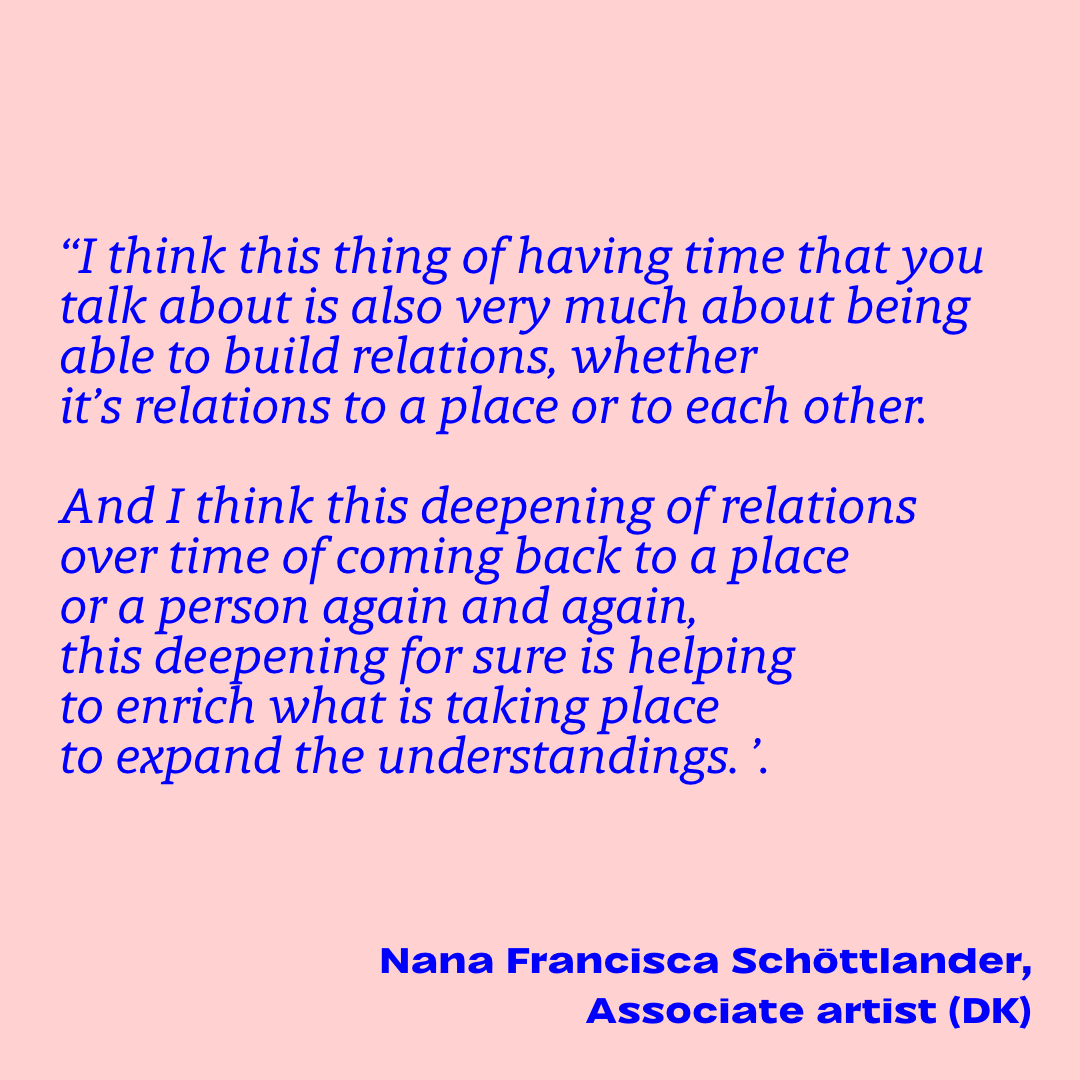
Nana Francisca Schottländer If I can comment on that. I think this thing of having time that you talk about is also very much about being able to build relations, whether it's relations to a place or to each other. And I think this deepening of relations over time of coming back to a place or a person again and again, this deepening for sure is helping to enrich what is taking place to to to expand the understandings. I think for me, like coming back to certain places over and over again, each time I learn something new, each time the place informs me of of new things or different dynamics. And doing it over time sort of settles it in like material that it then starts going into these processes and connections and something arises out of there. And I think the same it's the same thing with the relations, like sharing thoughts and ideas and, and processes over time and, and knowing each other's practices or what each other is interested in or curious about or challenged or provoked by is is really fruitful to be able to follow up on that ongoing dialog. So for sure, I think it's it has major benefits for me as an artist, but I think also for the projects that come out of it.
Eva Bubla And I think also it does not only happen within this pilot project but in IN SITU itself. So this four years, I find it just so useful and fruitful and I don't even know what words to use because we keep meeting in different locations and different contexts. I find it very inspiring to have these conversations also regarding it. I feel it does have an effect on my work, but also I find the work of others very inspiring. So this interaction is like super useful and fascinating here, like in this context as well and in the wider IN SITU context as well.
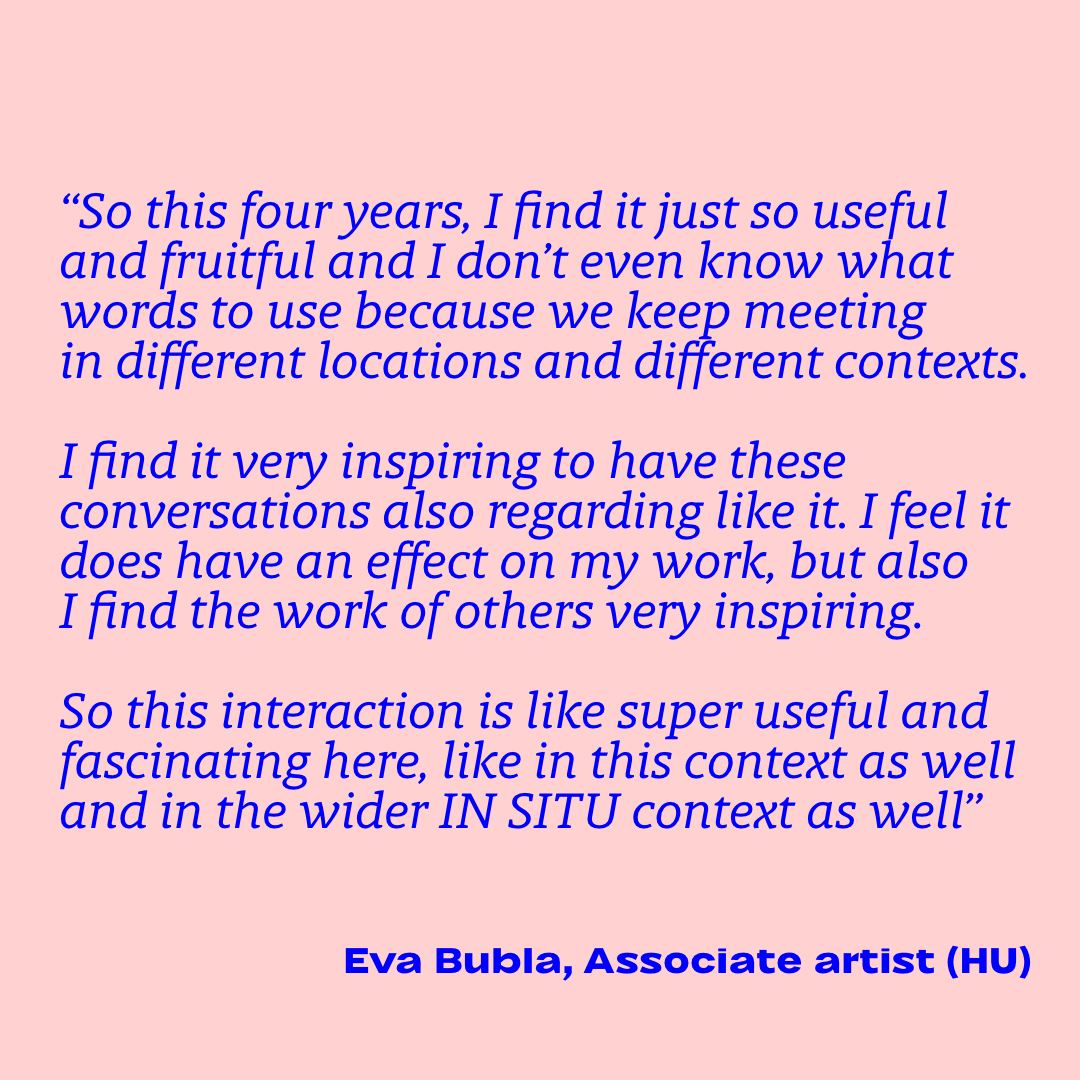
Nana Francisca Schottländer And I think also in terms of thinking this, whether you call it a Triennale or a un-festival or whatever, the vision is of this recurring thing. I think to think of these like long term processes or long term explorations and developing of relationships, I think is really key to doing something in a different way than just having a festival where people come and tour their work and everybody does everything at the same time for 14 days or a month or a week or whatever, and then everybody goes away again. But to really have this relational work over time, I think that could also be a very potent factor in developing a different format.
James Moore, ØIT But certainly one of the goals and one of the things we're trying to do, both in building a network around each of your practice or project, but then building a network around the (UN)COMMON SPACES, but also looking at how this what we're drawing on some relationships we've had. But each new artist and project also introduces new perspective partners and trying to find out how this crossover between the arts and the other sectors of society can produce something that we don't have because the challenges we're facing, we're not solving them quickly or well enough. And it requires that we inspire different ways of thinking, whether it's a statement that my audience latched on to, that art can change public space, but public space can also change art because you're you're out of a safe zone and you have to negotiate very differently. Taking it a little different direction, I'm really curious if you each ask a question of one another. Is there something that now that you also have been following practice and investigation of place? If there's a question you might ask of one of the other artists. I probably should have asked this earlier so you can think of it...
Eva Bubla But it's interesting. It just requires a little bit of thinking.
Eva Bubla So I kind of know what you're interested in, but I think what's what I find interesting is also what is problematic or what what challenges you on a artistic or personal level. I mean, I think it's difficult to be really clear about that, like to really phrase that question out, very specified, but I guess with each of you, it's interesting for me also to hear like, where does this trigger you or provoke or expand something.
Johannes Bellinkx I like that question also maybe what you're struggling with in your process I think it's also interesting. If I would ask somebody a question, it would be like that. So maybe Eva you can say something about that
[all laughing]
Johannes Bellinkx So I can also tell about my own struggle. What I find difficult is I've been in this production mode working on sites, getting Reverse together in three days. And when I was here, I really needed to force myself to relax and not to produce something in three days. Let the process, the process, and also accept that it's not there yet, or that it's not finished and that there's time to come back and to rethink everything and or throw everything away even, or that it's all possible. That's something I found difficult, like this time here, too. I asked for some time to be here, and then I was here and I was [grunting]. And just like Eva also been living here in this area, camping, which has been really good, really cool as well, also to get to know the place and be here also in the night. But having this process-approach on site, it feels also a bit like it's a privilege to be here. So I have to be quick and fast and use my time very efficiently. And and yeah, that's one of the things I'm struggling with.
Eva Bubla I think we share some struggles. Like as I mentioned, the reason why I wanted to move into this caravan on the land, because for me, one challenge was to find my own relation. The previous visits were pretty short also because the first time I was here for 4 or 5 days very shortly, and then for the second time as well. And now this will be longer because almost for a month and during the previous visits there were like very valuable, interesting conversations. But I couldn't really find my own relation to the land, and that was a challenge. And now it is kind of no longer a challenge because I'm there and experiencing it. It's an it's like all the elements and everything,.
Nana Francisca Schottländer Even the shit?
Eva Bubla Even the shit,yes. I forgot to mention that when I moved into the caravan there was two mountains or there were two mountains of shit next to it, which they spread the day after to fertilize the land. And now I have an olfactory installation inside and around the caravan. So it is definitely an experience. So be aware of what you wish for.
James Moore, ØIT Artist who's used to working with smells is now really with the extremity of smell.
Eva Bubla But that's the thing, in the morning I go, like what can happen if I smell. And they also found the one article that it can really like make your smelling less sensitive, weaker. So I started to stress like, okay, not that much, but my God, how will I do the work? Like the smell? What if all I really smell is just this one kind of, whatever is just a joke! So this challenge, so to say, is I think it's overcome. Like I overcame it. But then the other like, which is really challenging for me is that in this work, it's not yet decided the scale and like what exactly is going to happen there. But definitely I would like to have a mix of gardening/farming activities as well as installations. So during this month, it will become more clear. But working on this scale, on a bigger scale is a challenge for me because I have had projects, and also like personally, I have experience with gardening but not on an agricultural scale. So it's a challenge to think in this scale. And also of course because of this and for many other reasons, there are partners or there are collaborators in different roles within the project. And then the biggest challenge for me is how to come up with something which uses the expertise of all the people involved and satisfies all the people involved and how I can, basically like, have my position as an artist, like where it is like what what exactly it means and how this whole complex structure is born and how to maintain it. And yes, so this is the biggest challenge for me, I think.
James Moore, ØIT And just to be more precise, the field that we've been allocated to begin with is almost 15,000m². And when you take the the sort of rocky micro forest terrain around it, it's almost up to 50,000m². And that's still not including a small micro wetland area, just a short distance, but within the same structure. So it's a huge territory.
Eva Bubla Yes. So I hope in the next four years project also, there will be space for this because I think it can I think it's really a big or it can be. I mean, of course we scale it, but it's scalable. Yes.
James Moore, ØIT Your question returns.
Nana Francisca Schottländer Yeah. They tend to. There are so many things that I'm super fascinated with here. And the fascination only grows with each time I come back and explore deeper into the different places and dynamics and interrelations. I guess, like I'm immersing myself in that process and trying to allow for it not to crystallize into clear ideas, but at the same time I can feel a need to start crystallizing into clear ideas. They are there, but they feel very premature. So I guess it's also how you navigate a research process and come to a point where you then decide upon something whether or not that is fulfilling everything that it may could be if you researched for another ten years. Sometimes in these processes it's a lot about some kind of hunch or intuition, and it's like all this research, all this information, and then there's some kind of little hook that kind of tears itself into you, and you don't really understand why it's pulling at you. And I think for me, it's also allowing myself to follow that intuition without fully being able to explain why is this right? Or relevant or Yeah, but to, to trust that that is kind of the life of whatever it is I'm trying to say crystallized into some kind of artistic shape or material. I think for me, actually right now, the challenge is to to talk outloud about my ideas and to re-sound them and and have dialogs about them and start letting them live in the world.
James Moore, ØIT And another challenge that you're each faced with is that we still don't have full permissions to do what you want to do, where you want to do them.
Nana Francisca Schottländer Permissions is a big challenge.
James Moore, ØIT That's also another complicating factor that we have at least partners who really are curious and want to do something together. Several are about to be confronted with requests that are going to be very difficult to honor. So that's another exciting but also a serious unknown, that also puts me in the theater in an interesting situation since we're investing a lot in a direction without guarantee how this will unfold. But a kind of an underlying faith, partly based on experience, partly based on urgency, in fact, that these are all circumstances and processes that people should have a different relation to. And from my standpoint, believing that I mean, just another lecture or just another museum style visit won't do. So it's still how do you get through the body, through the senses, hope that people will reflect a little bit differently and maybe a little bit longer beyond their encounter about what they've been a part of, but that we still have to negotiate and navigate different kinds of hurdles.
Nana Francisca Schottländer I think in that sense, working like this in places where you're where there is restricted access, that process is in itself a relational artwork, building this trust and these relationships and finding the ways in and that in itself is a work of art. And then the experience that you have in there is what we call the work of art. But I actually think the whole process around it is, is very much part of that.
James Moore, ØIT The work is the process.
Nana Francisca Schottländer I'm also curious to see like how the concept of art or the idea of art can change in certain minds because you were talking about permissions and so on and talking about this project in Gudebergjordet, I remember that we had this discussion that because we will need to ask for permission to use the land for artistic purposes. And though the farmer who is working there, he's like super open about it, we have to talk with the city to get the permission. And then I remember that the lady who is in charge to give the permission, or at least the contact. At first she didn't really get it. Like what Art. Like what sense it would make to do that. But then I'm curious, like, how this could change because like, I guess her conception of art and what we are doing in public spaces might differ. So I'm curious about this process as well.
James Moore, ØIT And actually, more precisely, she wrote flat out that she didn't believe that art would ever be relevant enough for society to not be farming it like it's normally farmed.
Eva Bubla Yeah, but that's the thing that I think like how she imagines is not necessarily the same that we have in our mind. So as we can communicate clearly because also that in that phase there was nothing to communicate other than we are thinking of using the land. But I really believe, or I don't know, maybe I'm just too optimistic, but I really believe that it can change like and the moment, for instance, this person sees like what we mean by certain artistic activities, then the whole attitude towards art in public spaces can or like art and society can also change.
Nana Francisca Schottländer I think there is a lot of potential in coming in having this long term research as an artist to be able to sort of catalyze or see connections and dynamics that maybe you don't see when you walk around in them every day. And then I think what you said know about the relationships. I think it's really also about creating like making allies and creating alliances. And these alliances that happen through these processes can last way beyond an artwork or one of our artistic processes. So in a way, it's like a conductor, a conduzir like the artist as a sort of conducive for relations and themes coming to the fore and something coming into existence that can last beyond the artwork.

